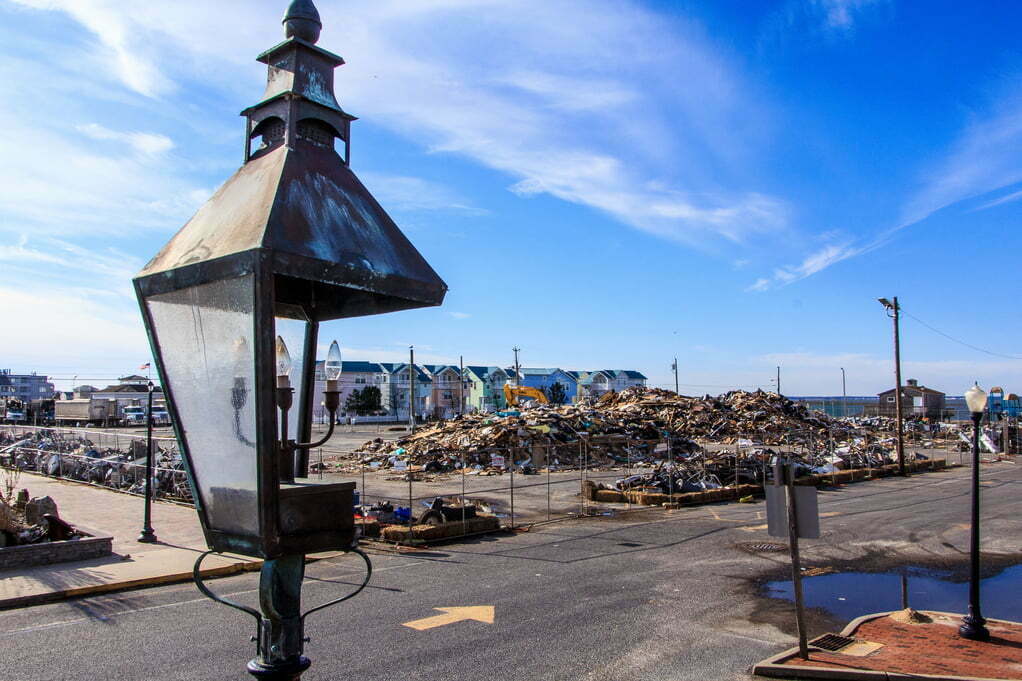Disaster Debris Recycling Tips

The residents have aggressively been removing debris in this New Jersey community. After Hurricane Sandy, piles of debris in Long Beach Island, New Jersey, were separated for recycling. Photo courtesy of FEMA.
Disaster debris recycling can have enormous cost-saving and environmental benefits for localities if executed and documented properly. These tips outline the major types of disaster recyclable debris, their end uses and challenges to successfully recycling each. Be sure to check out IBTS’s Debris Recycling Guide for more information on the debris recycling process and regulations.
Vegetative Debris
Typically one of the largest volume debris streams. Much of it can be diverted from disposal for use as lumber, chipping for mulch, composting or as fuel for power plants with wood-fired boilers.
- Major challenges:
- Disaster creates glut and over-capacity — the supply of vegetative debris after a disaster far exceeds the demand for co-generation fuel in nearby manufacturing facilities. Once the locality has to begin paying to ship it out to manufacturing facilities, it loses its cost-benefit.
- End uses of the most common vegetative debris recycled material include:
- Mulch, raw or colored
- Compost
- Fuel for co-generation facilities
- Landfill daily cover — localities can use 2” of wood waste instead of dirt
- Non-structural uses — logs, for example, can be milled for use as siding on a city shed
Construction & Demolition (C&D) Debris
Generated in large amounts in most disaster events. Depending on the composition and condition, it may be possible to divert much of this debris from disposal through construction and demolition debris processing facilities.
- Major challenges:
- If building debris contains obvious asbestos-infected materials, those materials must be sorted and managed separately from the rest of the debris and disposed of as asbestos waste. Otherwise, the entire amount of debris may need to be managed as asbestos containing materials.
- Glass — Difficult to get enough volume, hard to segregate and is often broken
- Plastic — Difficult because of co-mingling
- End uses of the most common C&D debris recycled material include:
- Scrap metal – typically a large volume of debris, highly recyclable if properly segregated
- Wood – may be recycled for non-structural use or chipping
- Concrete – viable, can be easily crushed and re-used
Large Appliances (White Goods)
One of the easiest, most straight-forward recycling processes.
- Major Challenges:
- Most refrigerators contain putrefied food, which can pose health risks and complicate processing of the recycled material (sheet metal, plastic, etc.)
- End uses of the most common recycled large appliances include:
- Crushed and bailed for scrap metal
- Tips:
- Residents setting out refrigerators and freezers for collection should be asked to remove all food and dispose of that separately as trash, and also to remove doors for safety
Electronics (E-Waste)
A wide range of e-waste can be sorted and recycled — PC’s, monitors, keyboards, mice, cell phones. Glass, plastics and electronic parts can be easily packaged for shipping in Gaylord boxes or shrink-wrapped pallets.
- Major Challenges:
- Re-use and recondition can be difficult after flooding. The majority of electronics cannot be reused or repurposed and must be recycled.
- End uses of the most common e-waste recycled materials include:
- Recyclers find end-uses for glass, plastics and some electronic parts.
- Tips:
- Use a tiered hierarchy system to segregate e-waste based on condition for re-use, reconditioning or recycling. Re-use and reconditioning are higher priority, if cost-effective.
Hazardous Wastes
Includes items such as lead acid batteries, compressed gas cylinders, oils, paints, consumer fuels, household bleach and other chemicals that should be collected for separate management and disposal.
- End uses of the most common recycled e-waste include:
- Consumer fuels and paints can be recycled for fuel
- Tips:
- Use trained and certified handlers and be sure they follow Resource Conservation & Recovery Act (RCRA) regulations
- Sort hazardous material by type
Small Motorized Equipment
Small motorized equipment, like lawnmowers, snowblowers and weed whackers, should be decommissioned and have fuel removed prior to recycling.
- End uses of the most common motorized equipment recycled material include:
- Metal, fuel and plastic (pelletized for injection molding)
- Tips:
- Use a tiered hierarchy system to segregate small motorized equipment based on condition for re-use, reconditioning or recycling. Re-use and reconditioning are higher priority, if cost-effective.
Vehicles & Vessels
Whether cars, trucks or boats, vehicles must be held to allow them to be claimed for insurance purposes and should be tracked by vehicle identification number (VIN) or license plate number.
- Major Challenges:
- Identifying and notifying vehicle/vessel owners can be time-consuming and tedious. After the owner is identify, they have 30 days to call and claim the vehicle before it is forfeited.
- Most vehicles/vessels have severe water damage and contamination. Many have already been stripped of valuable components, like hubcaps, stereos and parts, but can still be crushed for scrap metal.
- End uses of the most common recycled e-waste include:
- Crushed and bailed for scrap metal
- Tips:
- Use a tiered hierarchy system to segregate vehicles and vessels based on condition for re-use, reconditioning or recycling. Re-use and reconditioning are higher priority, if cost-effective.
Relevant legislation, policy or regulation:
PUBLIC LAW 94-580, Section 6002 — Resource Conservation and Recovery Act (PDF)
